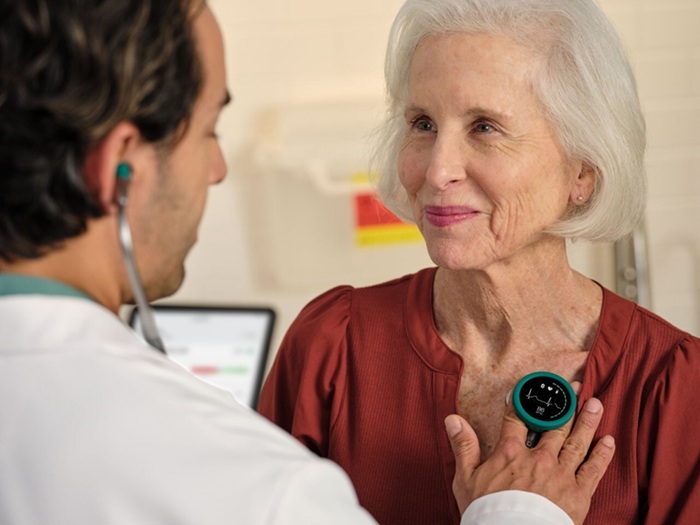New Study Demonstrates AI-Assisted Detection of Reduced Ejection Fraction
|
By HospiMedica International staff writers Posted on 06 Mar 2025 |

Heart failure is often diagnosed at an advanced stage, typically in acute settings when symptoms have already significantly progressed. Since its symptoms can be subtle and non-specific, many cases go undetected until considerable deterioration occurs. A common marker for identifying heart failure with reduced ejection fraction (HFrEF) is ejection fraction (EF), which measures the heart’s ability to pump blood effectively. Now, a new study has explored the potential of an artificial intelligence (AI) platform to help detect reduced EF, a critical indicator of heart failure.
The peer-reviewed study, published in JACC Advances, evaluated the effectiveness of Eko Health’s (San Francisco, CA, USA) FDA-cleared AI model in analyzing heart sounds and single-lead electrocardiogram (ECG) data obtained using a digital stethoscope to identify patients with significantly reduced EF (EF≤40%). The study involved 2,960 adults from four U.S. healthcare networks who were undergoing echocardiography. Data was captured using Eko's ECG-enabled digital stethoscope, ensuring that echocardiograms were performed within one week of data collection. The AI model was then compared with echocardiographic EF measurements, categorizing patients into two groups: normal/mildly reduced EF (>40%) and moderate/severely reduced EF (≤40%). The AI model demonstrated strong predictive capability, with an AUROC of 0.85, and achieved sensitivity and specificity of 77.5% and 78.3%, respectively.
Among the patients flagged by the AI as having potentially low EF but showing EF >40% on their echocardiograms, 25% had EF between 41-49%, and 63% exhibited conduction or rhythm abnormalities, suggesting that the AI model could also play a role in identifying patients who remain at cardiovascular risk. The performance of the AI model was consistent across various demographic and clinical groups, highlighting its broad applicability in clinical settings. The AI model is especially valuable for patients presenting with non-specific symptoms, such as unexplained dyspnea, as it can expedite access to diagnostic testing and treatment. Effective therapies for HFrEF exist and have been shown to improve patient outcomes when initiated early. By using AI-powered heart sound and ECG analysis, clinicians may gain further insights to support timely referrals to specialists, more comprehensive diagnostic evaluations, and better management of the disease.
"The study findings highlight the promise of Eko's platform to complement traditional diagnostics and address the critical challenge of underdiagnosed heart failure," said Connor Landgraf, CEO of Eko Health. "By integrating AI-driven insights into routine physical exams, we can help clinicians identify at-risk patients sooner, particularly in primary care and resource-limited settings."
Related Links:
Eko Health
Latest AI News
Channels
Surgical Techniques
view channel
Early TAVR Intervention Reduces Cardiovascular Events in Asymptomatic Aortic Stenosis Patients
Each year, approximately 300,000 Americans are diagnosed with aortic stenosis (AS), a serious condition that results from the narrowing or blockage of the aortic valve in the heart. Two common treatments... Read more
New Procedure Found Safe and Effective for Patients Undergoing Transcatheter Mitral Valve Replacement
In the United States, approximately four million people suffer from mitral valve regurgitation, the most common type of heart valve disease. As an alternative to open-heart surgery, transcatheter mitral... Read more
No-Touch Vein Harvesting Reduces Graft Failure Risk for Heart Bypass Patients
A coronary artery bypass graft (CABG) is a surgical procedure used to enhance blood flow and oxygen supply to the heart in individuals with coronary heart disease. During the procedure, a healthy blood... Read more
DNA Origami Improves Imaging of Dense Pancreatic Tissue for Cancer Detection and Treatment
One of the challenges of fighting pancreatic cancer is finding ways to penetrate the organ’s dense tissue to define the margins between malignant and normal tissue. Now, a new study uses DNA origami structures... Read morePatient Care
view channel
Portable Biosensor Platform to Reduce Hospital-Acquired Infections
Approximately 4 million patients in the European Union acquire healthcare-associated infections (HAIs) or nosocomial infections each year, with around 37,000 deaths directly resulting from these infections,... Read moreFirst-Of-Its-Kind Portable Germicidal Light Technology Disinfects High-Touch Clinical Surfaces in Seconds
Reducing healthcare-acquired infections (HAIs) remains a pressing issue within global healthcare systems. In the United States alone, 1.7 million patients contract HAIs annually, leading to approximately... Read more
Surgical Capacity Optimization Solution Helps Hospitals Boost OR Utilization
An innovative solution has the capability to transform surgical capacity utilization by targeting the root cause of surgical block time inefficiencies. Fujitsu Limited’s (Tokyo, Japan) Surgical Capacity... Read more
Game-Changing Innovation in Surgical Instrument Sterilization Significantly Improves OR Throughput
A groundbreaking innovation enables hospitals to significantly improve instrument processing time and throughput in operating rooms (ORs) and sterile processing departments. Turbett Surgical, Inc.... Read moreHealth IT
view channel
Printable Molecule-Selective Nanoparticles Enable Mass Production of Wearable Biosensors
The future of medicine is likely to focus on the personalization of healthcare—understanding exactly what an individual requires and delivering the appropriate combination of nutrients, metabolites, and... Read more
Smartwatches Could Detect Congestive Heart Failure
Diagnosing congestive heart failure (CHF) typically requires expensive and time-consuming imaging techniques like echocardiography, also known as cardiac ultrasound. Previously, detecting CHF by analyzing... Read moreBusiness
view channel
Expanded Collaboration to Transform OR Technology Through AI and Automation
The expansion of an existing collaboration between three leading companies aims to develop artificial intelligence (AI)-driven solutions for smart operating rooms with sophisticated monitoring and automation.... Read more















